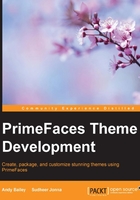
Conventions
In this book, you will find a number of styles of text that distinguish between different kinds of information. Here are some examples of these styles, and an explanation of their meaning.
Code words in text, database table names, folder names, filenames, file extensions, pathnames, dummy URLs, user input, and Twitter handles are shown as follows: "Fortunately, the schedule component provides a simple client-side API, which includes the update() method to save the bandwidth and increase the page load performance."
A block of code is set as follows:
<h:form id="mainform">
<h:panelGrid id="maintable" columns="2">
<h:outputLabel id="simpleLabel1" value="A standard inputText component:" for="standardInput"/>
<h:inputText id="standardInput"/>
<p:outputLabel id="pfLabel2" value="A PrimeFaces inputText component:" for="pfInput"/>
<p:inputText id="pfInput"/>
</h:panelGrid>
</h:form>
When we wish to draw your attention to a particular part of a code block, the relevant lines or items are set in bold:
<p:submenu id="chapter2" label="Chapter 2">
<p:menuitem id="c2difference" value="Differences" url="/chapter2/difference.xhtml"/>
<p:menuitem id="c2morecomponents" value="Mini Showcase" url="/chapter2/morecomponents.xhtml"/>
</p:submenu>
Any command-line input or output is written as follows:
git clone https://github.com/primefaces/showcase.git
New terms and important words are shown in bold. Words that you see on the screen, in menus or dialog boxes for example, appear in the text like this: "Choose the file or drag and drop the ThemeRoller theme in the ZIP format and click on the create theme jar button."